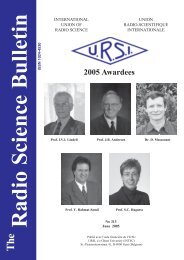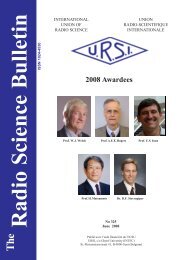Multi-physics Simulation for Radio Frequency Ion Trap ... - URSI
Multi-physics Simulation for Radio Frequency Ion Trap ... - URSI
Multi-physics Simulation for Radio Frequency Ion Trap ... - URSI
You also want an ePaper? Increase the reach of your titles
YUMPU automatically turns print PDFs into web optimized ePapers that Google loves.
density. Different from smoothness factor, delta smoothness factor will converge to zero independent of the type of<br />
field simulation and spatial filter.<br />
To fully prove our conclusions from previous cross section simulations, we per<strong>for</strong>med a 3-D ion trap design and<br />
simulations with comparison to corresponding experimental results. A 10×8×43.2 mm rectilinear ion trap is designed<br />
with a gap of 1mm in both simulation and experiment, as shown in Fig. 1 (a). In the experiment, the electrodes were<br />
made of stainless steel and tested in a vacuum manifold using Electron Impact (EI) ionization method. The compound<br />
1,3-dichlorobenzene (Aldrich Chemical Co., Inc.) was leaked into the vacuum manifold to an indicated pressure of ca.<br />
8×10 -7 Torr. Helium was used as the buffer gas at a pressure of 5×10 -5 Torr. The spectrum of 1,3-dichlorobenze was<br />
acquired using a mass selective instability scan (Fig. 3).<br />
Fig. 3. 3-D simulation results and experimental result of 1,3-dichlorobenzene.<br />
We use different mesh densities in simulation setup to acquire different field convergence quality. In this time,<br />
two mesh densities were tested; they are 38.75 and 137.5 Tetrahedron/mm 3 , respectively. To compare the results with<br />
the 2-D cross section cases, a cross section of the field is exported at z=0 and the smoothness factor is calculated. By<br />
using the narrow Gaussian spatial filter, the delta smoothness factors of these simulated fields are calculated as 1.47×10 -<br />
4 . Previous simulation results indicate that the field with mesh density 137.5 is smooth enough and the mass spectrum<br />
standard deviation of the spectrum should be within one mass range, which is around 5 volts from simulation and<br />
experiment results.<br />
5. Conclusion<br />
In this work, a multi-domain simulation tool is developed <strong>for</strong> characterizing ion trap chemical sensing. Electric<br />
field simulation, gas dynamic simulation and motion tracing simulation are integrated together. New convergence<br />
criterions, smoothness factor (S m ) and delta smoothness factor (∆S m ), are introduced and applied in mass spectrometry<br />
applications. By using these parameters, we can tell both the smoothness and the convergence of the solution without<br />
knowing the physical field solution. Results show that these factors agree very well with the accuracy of the field and<br />
can indicate the convergence of the field solution in both electric field simulation domain and chemical sensing domain.<br />
6. References<br />
[1] P. Wolfgang, "Electromagnetic <strong>Trap</strong>s <strong>for</strong> Charged and Neutral Particles (Nobel Lecture)," Angewandte Chemie<br />
International Edition in English, vol. 29, pp. 739-748, 1990.<br />
[2] M. G. Blain, L. S. Riter, D. Cruz, D. E. Austin, G. Wu, W. R. Plass, and R. G. Cooks, "Towards the hand-held<br />
mass spectrometer: design considerations, simulation, and fabrication of micrometer-scaled cylindrical ion<br />
traps," International Journal of Mass Spectrometry, vol. 236, pp. 91-104, 2004.<br />
[3] D. Kielpinski, C. Monroe, and D. J. Wineland, "Architecture <strong>for</strong> a large-scale ion-trap quantum computer,"<br />
Nature, vol. 417, pp. 709-711, 2002.<br />
[4] F. A. Londry, R. L. Alfred, and R. E. March, "Computer simulation of single-ion trajectories in Paul-type ion<br />
traps," Journal of the American Society <strong>for</strong> Mass Spectrometry, vol. 4, pp. 687-705, 1993.
















